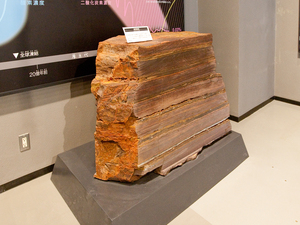Nagoya City Science Museum
TOP > Exhibition Guide > Keyword Search > Starting with "B" > banded iron formation > Evidence of Photosynthesis in Ancient Time
Evidence of Photosynthesis in Ancient Time



Purpose of Exhibition
The atmosphere containing oxygen is specific to the Earth. It is well known that the Earth's plant life generates oxygen in the atmosphere through the process of photosynthesis. The exhibit is symbolic of oxygen generation in the Earth's atmosphere.
Additional Knowledge
The big banded reddish brown rock. What in the world is it? It is called "banded iron formation" (picture), which is the evidence of the plant photosynthesis at the very dawn of time. Oxygen generation is presumed to have started some 2.7 to 3 billion years ago. The ancient ocean water contained a large amount of iron. My goodness! There emerged a certain kind of bacteria (cyanobacteria), a photosynthesizer, and generated oxygen, which combined with the iron contained in the ocean water to form iron oxide. Consequently, the iron oxide was precipitated to the ocean bottoms to form iron-ore deposits. That's how the banded iron formations occurred. The banded iron formations have been mined for scores of iron ores. Large quantities of iron ores are yielded in Australia and Canada, which are abundant in banded iron formations to the extent that they stretch all the way around the wilderness almost as far as the horizon. That evidences that where banded iron formations lie today, there were, at the very dawn of time, the oceans where oxygen was released through photosynthesis. At the sight of the banded iron formation on exhibit, you would find its banded appearance to be nothing short of a mystery. It is not evident as yet how its banded appearance came to occur. Conceivably, the peak precipitation periods of iron oxide and sand particles came alternately. In other words, presumably there existed seasonal changes, but no evidence is available. Another mystery is the fact that the pebble-containing formations occurred at nearly even intervals. It might amuse you to imagine what happened at the bottoms of the oceans 2.7 billions years ago. Incidentally, stromatolite can be referred to as home or colony to cyanobacteria. Stromatolite gradually grows by taking in sand particles in the water and solidifying with lime. Stromatolite's banded appearance is something like "annual growth rings." Cyanobacteria live on the surface of stromatolite. The mere fact alone makes us feel a powerful sense of the Earth's history that microorganisms made up rocks, such as the one on exhibit here, over a whopping long period of time.
Cooperation: Data: Presented by Shigenori Maruyama of Tokyo Institute of TechnologyArticle by Shoji Nishimoto, curator
